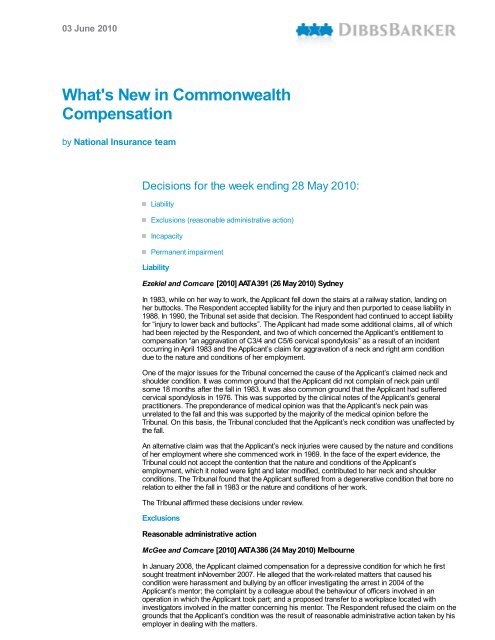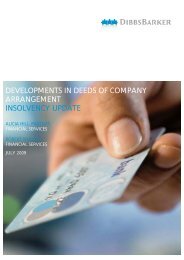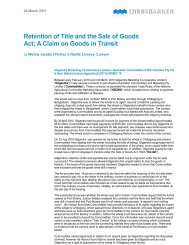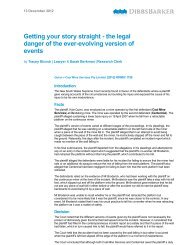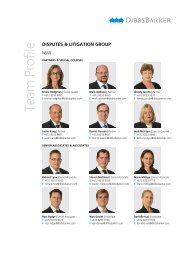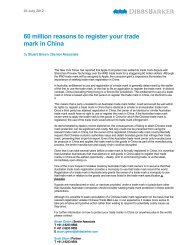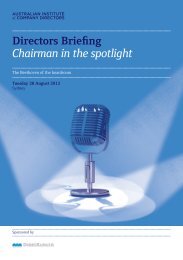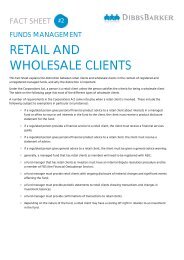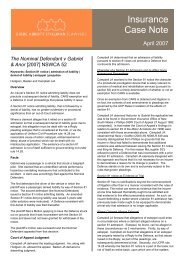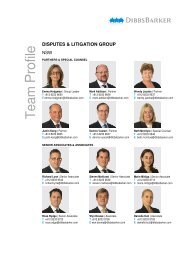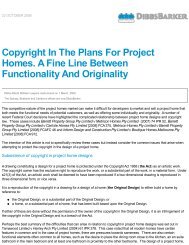What's New in Commonwealth Compensation - DibbsBarker
What's New in Commonwealth Compensation - DibbsBarker
What's New in Commonwealth Compensation - DibbsBarker
Create successful ePaper yourself
Turn your PDF publications into a flip-book with our unique Google optimized e-Paper software.
03 June 2010<br />
<strong>What's</strong> <strong>New</strong> <strong>in</strong> <strong>Commonwealth</strong><br />
<strong>Compensation</strong><br />
by National Insurance team<br />
Decisions for the week end<strong>in</strong>g 28 May 2010:<br />
Liability<br />
Exclusions (reasonable adm<strong>in</strong>istrative action)<br />
Incapacity<br />
Permanent impairment<br />
Liability<br />
Ezekiel and Comcare [2010] AATA 391 (26 May 2010) Sydney<br />
In 1983, while on her way to work, the Applicant fell down the stairs at a railway station, land<strong>in</strong>g on<br />
her buttocks. The Respondent accepted liability for the <strong>in</strong>jury and then purported to cease liability <strong>in</strong><br />
1988. In 1990, the Tribunal set aside that decision. The Respondent had cont<strong>in</strong>ued to accept liability<br />
for “<strong>in</strong>jury to lower back and buttocks”. The Applicant had made some additional claims, all of which<br />
had been rejected by the Respondent, and two of which concerned the Applicant’s entitlement to<br />
compensation “an aggravation of C3/4 and C5/6 cervical spondylosis” as a result of an <strong>in</strong>cident<br />
occurr<strong>in</strong>g <strong>in</strong> April 1983 and the Applicant’s claim for aggravation of a neck and right arm condition<br />
due to the nature and conditions of her employment.<br />
One of the major issues for the Tribunal concerned the cause of the Applicant’s claimed neck and<br />
shoulder condition. It was common ground that the Applicant did not compla<strong>in</strong> of neck pa<strong>in</strong> until<br />
some 18 months after the fall <strong>in</strong> 1983. It was also common ground that the Applicant had suffered<br />
cervical spondylosis <strong>in</strong> 1976. This was supported by the cl<strong>in</strong>ical notes of the Applicant’s general<br />
practitioners. The preponderance of medical op<strong>in</strong>ion was that the Applicant’s neck pa<strong>in</strong> was<br />
unrelated to the fall and this was supported by the majority of the medical op<strong>in</strong>ion before the<br />
Tribunal. On this basis, the Tribunal concluded that the Applicant’s neck condition was unaffected by<br />
the fall.<br />
An alternative claim was that the Applicant’s neck <strong>in</strong>juries were caused by the nature and conditions<br />
of her employment where she commenced work <strong>in</strong> 1969. In the face of the expert evidence, the<br />
Tribunal could not accept the contention that the nature and conditions of the Applicant’s<br />
employment, which it noted were light and later modified, contributed to her neck and shoulder<br />
conditions. The Tribunal found that the Applicant suffered from a degenerative condition that bore no<br />
relation to either the fall <strong>in</strong> 1983 or the nature and conditions of her work.<br />
The Tribunal affirmed these decisions under review.<br />
Exclusions<br />
Reasonable adm<strong>in</strong>istrative action<br />
McGee and Comcare [2010] AATA 386 (24 May 2010) Melbourne<br />
In January 2008, the Applicant claimed compensation for a depressive condition for which he first<br />
sought treatment <strong>in</strong>November 2007. He alleged that the work-related matters that caused his<br />
condition were harassment and bully<strong>in</strong>g by an officer <strong>in</strong>vestigat<strong>in</strong>g the arrest <strong>in</strong> 2004 of the<br />
Applicant’s mentor; the compla<strong>in</strong>t by a colleague about the behaviour of officers <strong>in</strong>volved <strong>in</strong> an<br />
operation <strong>in</strong> which the Applicant took part; and a proposed transfer to a workplace located with<br />
<strong>in</strong>vestigators <strong>in</strong>volved <strong>in</strong> the matter concern<strong>in</strong>g his mentor. The Respondent refused the claim on the<br />
grounds that the Applicant’s condition was the result of reasonable adm<strong>in</strong>istrative action taken by his<br />
employer <strong>in</strong> deal<strong>in</strong>g with the matters.
There was no dispute that the Applicant suffered from a psychological condition which, on the<br />
medical evidence, the Tribunal found was best characterised as “depressive disorder” which was an<br />
ailment that was contributed to, to a significant degree, by his employment. Therefore the issue<br />
before the Tribunal was whether the ailment was suffered as a result of reasonable adm<strong>in</strong>istrative<br />
action taken <strong>in</strong> a reasonable manner <strong>in</strong> respect of the Applicant’s employment such as to exclude<br />
him from receiv<strong>in</strong>g compensation <strong>in</strong> accordance with s 5A(1) of the Safety, Rehabilitation and<br />
<strong>Compensation</strong> Act 1988 (Cth) (“1988 Act”) because it would not constitute an “<strong>in</strong>jury”.<br />
The Tribunal firstly found that each of the matters raised <strong>in</strong> the Applicant’s claim were actions by<br />
management which <strong>in</strong>volved staff, and that each constituted “adm<strong>in</strong>istrative action” for the purposes<br />
of the 1988 Act. The Applicant alleged that the adm<strong>in</strong>istrative action <strong>in</strong> relation to the three matters<br />
was unreasonable. On the factual evidence before it, the Tribunal found that the adm<strong>in</strong>istrative<br />
action <strong>in</strong>volv<strong>in</strong>g all three matters was reasonable and taken <strong>in</strong> a reasonable manner. Furthermore,<br />
the Tribunal was satisfied that that the adm<strong>in</strong>istrative action <strong>in</strong> the three matters was taken <strong>in</strong><br />
respect of the Applicant’s employment and those matters caused the depressive condition suffered<br />
by the Applicant.<br />
In view of its f<strong>in</strong>d<strong>in</strong>gs, the Tribunal was satisfied that the condition suffered by the Applicant resulted<br />
from reasonable adm<strong>in</strong>istrative action taken <strong>in</strong> a reasonable manner <strong>in</strong> respect of his employment,<br />
so it did not come with<strong>in</strong> the def<strong>in</strong>ition of “<strong>in</strong>jury” <strong>in</strong> the 1988 Act. Although there may have been other<br />
matters that contributed to the condition, no compensation was payable <strong>in</strong> accordance with the<br />
pr<strong>in</strong>ciples espoused <strong>in</strong> Hart v Comcare [2005] FCAFC 16; (2005) 145 FCR 29.<br />
The Tribunal affirmed the decision under review.<br />
Wilson and Comcare [2010] AATA 396 (28 May 2010) Canberra<br />
The Applicant submitted a claim for workers’ compensation <strong>in</strong> May 2008 for “anxiety” due to “ongo<strong>in</strong>g<br />
systemic unacceptable behaviour”, stress and bully<strong>in</strong>g. In November 2008, the Respondent<br />
determ<strong>in</strong>ed that the Applicant was not entitled to compensation under section 14 of the Safety,<br />
Rehabilitation and <strong>Compensation</strong> Act 1988 (Cth) (“1988 Act”) for “adjustment reaction with mixed<br />
emotional features” on the basis that, although the Applicant’s condition was contributed to, to a<br />
significant degree, by his employment, the condition was the result of “reasonable adm<strong>in</strong>istrative<br />
action” and thus not an “<strong>in</strong>jury” with<strong>in</strong> the mean<strong>in</strong>g of section 5A of the 1988 Act.<br />
In these proceed<strong>in</strong>gs, the parties agreed that s<strong>in</strong>ce the Applicant had conceded that the Applicant’s<br />
condition had been contributed to, to a significant degree, by his employment, the sole issue was<br />
whether the Applicant’s condition was suffered as a result of reasonable adm<strong>in</strong>istrative action taken<br />
<strong>in</strong> a reasonable manner <strong>in</strong> respect of his employment.<br />
The Tribunal found that the relevant adm<strong>in</strong>istrative actions <strong>in</strong>cluded: the Applicant not receiv<strong>in</strong>g<br />
Additional Responsibility Pay (“ARP”) at the level he expected; the <strong>in</strong>formal counsell<strong>in</strong>g session <strong>in</strong><br />
September 2007; the steps taken relat<strong>in</strong>g to the Applicant’s Performance Agreement 2006-2007; the<br />
processes surround<strong>in</strong>g the imposition of a Performance Improvement Process (“PIP”); and the<br />
meet<strong>in</strong>gs relat<strong>in</strong>g to the PIP <strong>in</strong> November and December 2007.<br />
The pr<strong>in</strong>cipal issue was whether the examples of adm<strong>in</strong>istrative action taken by the employer that<br />
affected the Applicant were “reasonable” for the purposes of section 5A(2) of the 1988 Act. In relation<br />
to the first adm<strong>in</strong>istrative action, the Tribunal noted that although the Applicant compla<strong>in</strong>ed about not<br />
receiv<strong>in</strong>g ARP at the expected level, and that there were delays <strong>in</strong> implement<strong>in</strong>g the arrangement,<br />
when offered the opportunity to pursue the matter the Applicant chose not to do so. In the<br />
circumstances, and given the absence of evidence from the Applicant on key issues, the Tribunal<br />
was not able to be satisfied as to whether the Applicant had a legitimate grievance on this issue and<br />
made no f<strong>in</strong>d<strong>in</strong>gs accord<strong>in</strong>gly.<br />
As to the second example of adm<strong>in</strong>istrative action, the Tribunal found there was noth<strong>in</strong>g “untoward”<br />
about the call<strong>in</strong>g or conduct of the meet<strong>in</strong>g, nor was it “irrational, absurd or ridiculous”. The action<br />
did not fall with<strong>in</strong> “bully<strong>in</strong>g” or “abuse of power”. Given that the Applicant’s work errors were clearly<br />
not acceptable behaviour, to arrange a meet<strong>in</strong>g with the Applicant to discuss the matter and counsel<br />
him was appropriate, and to do so <strong>in</strong>formally complied with the employer’s policies and pr<strong>in</strong>ciples. It<br />
followed that the Tribunal found that tak<strong>in</strong>g this step was lawful, and was reasonable adm<strong>in</strong>istrative<br />
action taken <strong>in</strong> a reasonable manner.<br />
Regard<strong>in</strong>g the steps taken relat<strong>in</strong>g to the Applicant’s Performance Agreement 2006-2007, the<br />
Tribunal considered that decisions made by management <strong>in</strong> this regard were both lawful and<br />
reasonable adm<strong>in</strong>istrative action. In terms of the imposition of the PIP, the Tribunal held that this<br />
process was <strong>in</strong>stituted <strong>in</strong> a reasonable manner. With respect to the meet<strong>in</strong>gs held with the Applicant<br />
<strong>in</strong> November and December 2007, the Tribunal held that the hold<strong>in</strong>g of the meet<strong>in</strong>gs and how they<br />
were conducted was not unfair and <strong>in</strong> those circumstances, the action taken was not unreasonable,<br />
nor were they taken out with a “deliberate desire to hurt, threaten or frighten someone with words or<br />
actions”. Given that the actions did not constitute bully<strong>in</strong>g, they were not undertaken <strong>in</strong> an<br />
unreasonable manner.<br />
The Tribunal highlighted that whilst some of the <strong>in</strong>teractions between the Applicant and his manager<br />
concerned the tak<strong>in</strong>g of adm<strong>in</strong>istrative action, and on their own would not be reasonable, <strong>in</strong> the<br />
circumstances, and given that reasonable action does not have to be perfect, provided it was<br />
“tolerable and fair”, the Tribunal did not f<strong>in</strong>d that these issues were an unreasonable manner of<br />
undertak<strong>in</strong>g various adm<strong>in</strong>istrative actions <strong>in</strong>volv<strong>in</strong>g the Applicant. In conclusion, the Tribunal upheld
the f<strong>in</strong>d<strong>in</strong>g that the adm<strong>in</strong>istrative action taken <strong>in</strong> relation to the Applicant, <strong>in</strong> particular by his regional<br />
manger, were reasonable adm<strong>in</strong>istrative actions be<strong>in</strong>g lawful and appropriate <strong>in</strong> the circumstances<br />
and they were not taken <strong>in</strong> an unreasonable manner.<br />
The Tribunal affirmed the decision under review.<br />
Incapacity<br />
Ezekiel and Comcare [2010] AATA 391 (26 May 2010) Sydney<br />
One of the applications brought by the Applicant concerned her claim for <strong>in</strong>capacity payments for<br />
her accepted back condition under section 19 of the Safety, Rehabilitation and <strong>Compensation</strong> Act<br />
1988 (Cth) (“1988 Act”).<br />
The Tribunal considered that the preponderance of medical evidence was that <strong>in</strong> 1995<br />
the Applicant was partially <strong>in</strong>capacitated for work and was able to perform clerical duties for four<br />
hours per day for five days per week. At the time she left, she had suitable work of that k<strong>in</strong>d and for<br />
those hours was available to her. The Tribunal considered, on the basis of the balance of expert<br />
medical evidence, that it was not reasonable <strong>in</strong> all of the circumstances for the Applicant to have not<br />
cont<strong>in</strong>ued <strong>in</strong> that suitable employment. In reach<strong>in</strong>g this conclusion the Tribunal was m<strong>in</strong>dful of the<br />
Applicant’s stated difficulty <strong>in</strong> cont<strong>in</strong>u<strong>in</strong>g to work, however, it did not consider that her difficulty was<br />
so great that she was unable to cont<strong>in</strong>ue to work or that she had “no choice”, as it has been put on<br />
her behalf, but to take voluntary redundancy.<br />
The Tribunal noted that there was no direct medical evidence of marked deterioration over the last<br />
15 years. The Tribunal accepted that advanc<strong>in</strong>g age would generally affect any person’s capacity to<br />
some greater or lesser extent but <strong>in</strong> the absence of any objective evidence of dim<strong>in</strong>ished capacity to<br />
work, or any current assessment of her current capacity to perform the type of employment she<br />
undertook <strong>in</strong> 1995, the Tribunal could not be satisfied that the work the Applicant left <strong>in</strong> 1995 was no<br />
longer suitable employment.<br />
On this basis, the Tribunal considered that the Applicant’s failure to cont<strong>in</strong>ue to engage <strong>in</strong> suitable<br />
employment was not reasonable and that any calculation of payments under section 19 of the 1988<br />
Act should have <strong>in</strong>corporated earn<strong>in</strong>gs <strong>in</strong> suitable employment of 20 hours per week. The Tribunal<br />
noted that the Applicant received a lump sum superannuation payment and thus the relevant<br />
provisions of the 1988 Act concern<strong>in</strong>g the effect of such payments on the calculation of weekly<br />
<strong>in</strong>capacity payments were also applicable.<br />
To the extent that the reviewable decision <strong>in</strong> question stated that the Applicant had no current<br />
entitlement to <strong>in</strong>capacity payments, the Tribunal set aside the decision and remitted it to the<br />
Respondent with directions that the Applicant was partially <strong>in</strong>capacitated for work <strong>in</strong> that she was<br />
able to earn <strong>in</strong> suitable employment of 20 hours per week and, <strong>in</strong> respect of calculat<strong>in</strong>g a weekly<br />
<strong>in</strong>capacity payment, if any, she was retired from her employment and had received a lump sum<br />
benefit under a superannuation scheme.<br />
James and Comcare [2010] AATA 393 (27 May 2010) Canberra<br />
The Applicant had two accepted <strong>in</strong>juries to his left knee – a stra<strong>in</strong> to the cruciate ligament and<br />
aggravation of osteoarthrosis. In February 2008, he underwent left knee replacement surgery and he<br />
claimed compensation for two periods of <strong>in</strong>capacity. The Applicant’s entitlement to <strong>in</strong>capacity dur<strong>in</strong>g<br />
these periods was determ<strong>in</strong>ed <strong>in</strong> the negative <strong>in</strong> two separate decisions, and this was affirmed upon<br />
reconsideration.<br />
The issue for determ<strong>in</strong>ation was whether the Applicant was entitled to compensation for <strong>in</strong>capacity<br />
dur<strong>in</strong>g these periods. Essentially, to be so entitled, the Tribunal noted it must have been established<br />
that the periods of <strong>in</strong>capacity resulted from an “<strong>in</strong>jury” under the Safety, Rehabilitation and<br />
<strong>Compensation</strong> Act 1988 (Cth) (“1988 Act”). The Applicant asserted that the periods of <strong>in</strong>capacity<br />
resulted from one or more compensable <strong>in</strong>juries to his left knee.<br />
Based on the medical evidence before it, the Tribunal was reasonably satisfied, that the work-related<br />
<strong>in</strong>cidents <strong>in</strong> March 2006, May 2006 and September 2007 caused m<strong>in</strong>or traumas that were<br />
consistent with m<strong>in</strong>or frank <strong>in</strong>juries, and those m<strong>in</strong>or <strong>in</strong>juries caused the Applicant’s pseudogout<br />
symptoms to flare for a short period. It could be accepted that the <strong>in</strong>juries caused <strong>in</strong>capacity for<br />
work dur<strong>in</strong>g those short periods, however, once the elevated symptoms dim<strong>in</strong>ished, the Applicant’s<br />
left knee condition returned to a state <strong>in</strong>volv<strong>in</strong>g persistent and <strong>in</strong>creas<strong>in</strong>g symptoms and ongo<strong>in</strong>g<br />
<strong>in</strong>capacity for work, <strong>in</strong> vary<strong>in</strong>g degrees.<br />
The Tribunal was reasonably satisfied that these persistent symptoms and degrees of <strong>in</strong>capacity for<br />
work were attributable to the progress of his pre-exist<strong>in</strong>g degenerative disease and not to the m<strong>in</strong>or<br />
<strong>in</strong>juries and related elevation of symptoms <strong>in</strong> March 2006, May 2006 and September 2007.<br />
Therefore, <strong>in</strong> conclusion, the Tribunal found that the claimed periods of <strong>in</strong>capacity were not the result<br />
of an “<strong>in</strong>jury” for the purposes of the 1988 Act.<br />
The Tribunal affirmed the decision under review.<br />
Permanent impairment<br />
Dean and Military Rehabilitation and <strong>Compensation</strong> Commission [2010] AATA 388 (25 May<br />
2010) Canberra
In terms of the Applicant’s back condition, it was common ground that, pursuant to section 124 of<br />
the Safety, Rehabilitation and <strong>Compensation</strong> Act 1988 (Cth) (“1988 Act”), liability for permanent<br />
impairment of the Applicant’s back would only arise if the impairment became permanent after 1<br />
Liability was accepted under the Safety, Rehabilitation and <strong>Compensation</strong> Act 1988 (Cth) (“1988<br />
Act”) for the Applicant’s “m<strong>in</strong>or annular tear of the L5/S1 disc result<strong>in</strong>g <strong>in</strong> degenerative changes at<br />
the L4/L5 and L5/S1 level” with effect from 10 June 1991. Subsequently, liability was accepted for<br />
conditions of chronic adjustment disorder, pa<strong>in</strong> disorder and major depressive disorder. The<br />
Respondent <strong>in</strong>itially decided <strong>in</strong> April 2009 that the Applicant was assessed as hav<strong>in</strong>g a whole person<br />
impairment of 15 per cent under Table 5.1 of the first edition of the Comcare Guide for his chronic<br />
adjustment disorder only. That decision was affirmed on reconsideration. In June 2009 on further<br />
reconsideration, the delegate varied the decision to assess whole person impairment of 15 per cent<br />
for major depressive disorder and pa<strong>in</strong> disorder <strong>in</strong>stead of chronic adjustment disorder.<br />
The follow<strong>in</strong>g issues were relevant to these proceed<strong>in</strong>gs:<br />
Whether the Applicant’s conditions were permanent<br />
Whether the assessment of whole person impairment under the Comcare Guide for one or more<br />
of the Applicant’s conditions should have been higher than 15 per cent<br />
What were the appropriate scores under Division 2 of the Guide for any non-economic loss<br />
suffered by the Applicant for all or any of his accepted conditions<br />
Whether the Applicant was entitled to a further payment of compensation and, if so, the amount of<br />
the additional compensation<br />
Whether the Respondent was entitled to deduct an overpayment of <strong>in</strong>capacity payments from an<br />
award of lump sum compensation<br />
Whether some or all of the deduction of the overpayment should have been waived<br />
In terms of the first issue, the Tribunal considered that the overwhelm<strong>in</strong>g medical evidence enabled<br />
it to f<strong>in</strong>d that the Applicant’s condition was permanent. That did not preclude the possibility of some<br />
relief <strong>in</strong> his symptoms should the Applicant have agreed to take anti-depressants at some stage and<br />
undergo a pa<strong>in</strong> management program. However, these possibilities, for practical reasons and <strong>in</strong> the<br />
face of the Applicant’s attitude to tak<strong>in</strong>g medication, appeared to be remote.<br />
Regard<strong>in</strong>g the second issue, the Tribunal noted that there was less uniformity among the medical<br />
experts as to the Applicant’s assessment of whole person impairment for his conditions under Table<br />
5.1 of the Comcare Guide. Nor did all the experts provide such an assessment. Hav<strong>in</strong>g undertaken a<br />
detailed analysis of the requirements under the Comcare Guide, <strong>in</strong> conjunction with the provisions of<br />
the 1988 Act and relevant case law, the Tribunal found that, based on the predom<strong>in</strong>ant medical<br />
evidence and its own f<strong>in</strong>d<strong>in</strong>gs, the Applicant’s level of permanent impairment for his major<br />
depressive disorder met the criteria of 25 per cent under the Comcare Guide. The evidence also led<br />
to a f<strong>in</strong>d<strong>in</strong>g that the assessment for the Applicant’s pa<strong>in</strong> disorder should also be set at 25 per cent.<br />
The Tribunal noted that if it was <strong>in</strong> error <strong>in</strong> attempt<strong>in</strong>g to apportion the impairment between the two<br />
conditions, it made a f<strong>in</strong>d<strong>in</strong>g that the Applicant was entitled to 25 per cent for both conditions <strong>in</strong><br />
comb<strong>in</strong>ation.<br />
With respect to the third issue, the Tribunal noted that there was little evidence at the hear<strong>in</strong>g on this<br />
issue. In the absence of further evidence on this issue the Tribunal was not <strong>in</strong> a position to make an<br />
assessment and accord<strong>in</strong>gly it remitted the matter to the Respondent for that purpose.<br />
In terms of whether the Applicant was entitled to a further payment of compensation and, if so, the<br />
amount of the additional compensation, the Tribunal observed that there was no argument at the<br />
hear<strong>in</strong>g <strong>in</strong> support of this issue and accord<strong>in</strong>gly the Tribunal made no f<strong>in</strong>d<strong>in</strong>gs.<br />
In terms of whether the Respondent was entitled to deduct an overpayment of <strong>in</strong>capacity payments<br />
from an award of lump sum compensation, the Respondent adopted the follow<strong>in</strong>g pr<strong>in</strong>ciples for<br />
decid<strong>in</strong>g whether to waive any or all of an overpayment. These were whether the Respondent or, it<br />
was assumed, an agency, made an error, whether the payment was received <strong>in</strong> good faith by the<br />
debtor, and any other reasonable grounds, <strong>in</strong>clud<strong>in</strong>g severe f<strong>in</strong>ancial hardship or exceptional<br />
circumstances. Aga<strong>in</strong>, little evidence or argument was provided to the Tribunal on this issue. In<br />
these circumstances, although there had been a degree of departmental error, and the Applicant<br />
received an extra amount <strong>in</strong> good faith, the Tribunal did not consider there were sufficiently strong<br />
grounds for the exercise of the waiver power.<br />
The Tribunal set aside the decision under review and <strong>in</strong> substitution the Tribunal found that the<br />
Applicant had a 25 per cent permanent impairment for each of his major depressive disorder and his<br />
pa<strong>in</strong> disorder. The Tribunal remitted the question of the appropriate score under Division 2 of the<br />
Comcare Guide for any non-economic loss suffered by the Applicant for each of his conditions to the<br />
Respondent.<br />
Ezekiel and Comcare [2010] AATA 391 (26 May 2010) Sydney<br />
One of the issues for the Tribunal <strong>in</strong> these proceed<strong>in</strong>gs concerned the time at which the<br />
impairments to the Applicant’s back, legs, neck and shoulders, if any, became permanent.
December 1988. In relation to her back, the Applicant’s evidence was that s<strong>in</strong>ce the date of the fall <strong>in</strong><br />
1983 she had suffered constant low back pa<strong>in</strong> and stiffness. Early reports and cl<strong>in</strong>ical notes of<br />
treat<strong>in</strong>g doctors supported that evidence. Of the various medical op<strong>in</strong>ions, only one of the doctors<br />
ma<strong>in</strong>ta<strong>in</strong>ed that the impairment did not become permanent until after 1 December 1988. On the<br />
background of this evidence, the Applicant sought to establish permanence of that impairment only<br />
after December 1988 by urg<strong>in</strong>g the Tribunal to regard a referral to a pa<strong>in</strong> cl<strong>in</strong>ic <strong>in</strong> 1989 and a<br />
discussion <strong>in</strong> 1990 with one of her treat<strong>in</strong>g doctors about a possible sp<strong>in</strong>al fusion as <strong>in</strong>dications of<br />
the time at which the Applicant had undertaken “all reasonable rehabilitative treatment for the<br />
impairment”.<br />
With reference to the other factors mentioned <strong>in</strong> section 24(2) of the 1988 Act, the duration of the<br />
impairment had been more than five years s<strong>in</strong>ce the fall. The Tribunal noted that the likelihood of<br />
improvement, the other listed factor <strong>in</strong> section 24(2), tended to dim<strong>in</strong>ish as time went by and, given<br />
the medical evidence about the significance of one of the doctor’s rais<strong>in</strong>g the possibility of a sp<strong>in</strong>al<br />
fusion <strong>in</strong> 1990, the Tribunal did not th<strong>in</strong>k that the mere existence of the possibility of an alternate<br />
course of treatment about which medical op<strong>in</strong>ion was divided was sufficient to render a longstand<strong>in</strong>g<br />
condition not permanent. On this basis, the Tribunal considered that any impairment of the<br />
Applicant’s back was permanent before 1 December 1988.<br />
In relation to the impairment to the Applicant’s legs, it was submitted for the Applicant that the<br />
contested impairment to her legs should be “bundled together” with that of her back; that the time at<br />
which her back impairment became permanent was the same po<strong>in</strong>t at which her leg impairment<br />
became permanent. On this basis, and given the conclusion relation to the Applicant’s back, it<br />
followed that any impairment to her legs became permanent prior to 1 December 1988. The Tribunal<br />
<strong>in</strong>dicated that there was comparatively little medical evidence of any discrete impairment of the<br />
Applicant’s legs.<br />
In light of the Tribunal’s f<strong>in</strong>d<strong>in</strong>gs regard<strong>in</strong>g liability for the Applicant’s neck and shoulders condition<br />
outl<strong>in</strong>ed above under “Liability”, it was unnecessary for the Tribunal to consider the issue of<br />
permanence <strong>in</strong> relation to those conditions.<br />
The Tribunal affirmed these decisions under review.<br />
For more <strong>in</strong>formation -<br />
Please contact a member of our national Insurance team.<br />
The material conta<strong>in</strong>ed <strong>in</strong> this publication is no more than general comment. Readers should not<br />
act on the basis of the material without tak<strong>in</strong>g professional advice relat<strong>in</strong>g to their particular<br />
circumstances.<br />
The <strong>in</strong>formation <strong>in</strong> this document, broadcast or communication is provided for general guidance only. It is not legal advice, and should<br />
not be used as a substitute for consultation with professional legal or other advisors. No warranty is given to the correctness of the<br />
<strong>in</strong>formation conta<strong>in</strong>ed <strong>in</strong> this document, broadcast or communication or its suitability for use by you. To the fullest extent permitted by<br />
law, no liability is accepted by <strong>DibbsBarker</strong> for any statement or op<strong>in</strong>ion, or for an error or omission or for any loss or damage<br />
suffered as a result of reliance on or use by any person of any material <strong>in</strong> the document, broadcast or communication.<br />
This publication is copyright. Apart from any use as permitted under the Copyright Act 1968, it may only be reproduced for <strong>in</strong>ternal<br />
bus<strong>in</strong>ess purposes, and may not otherwise be copied, adapted, amended, published, communicated or otherwise made available to<br />
third parties, <strong>in</strong> whole or <strong>in</strong> part, <strong>in</strong> any form or by any means, without the prior written consent of <strong>DibbsBarker</strong>.


